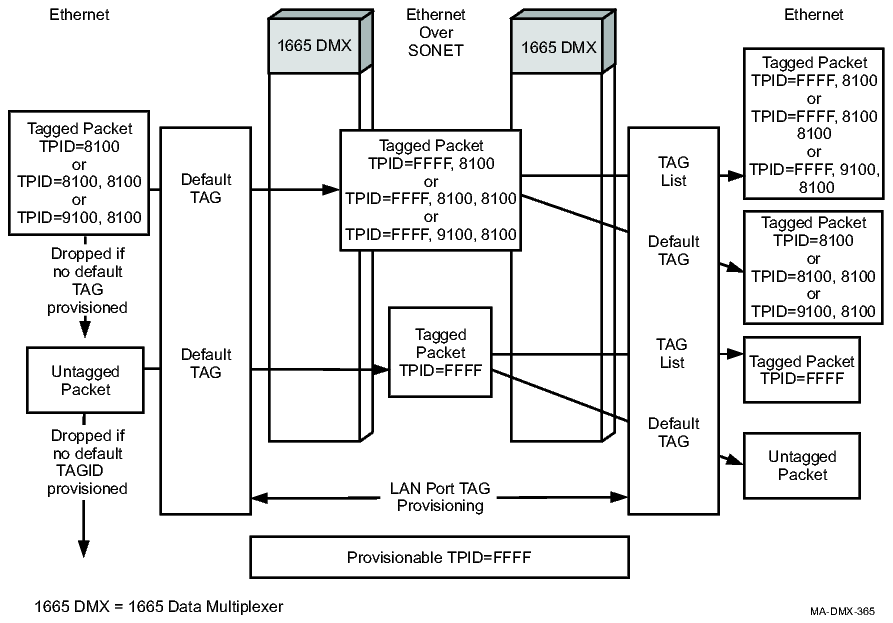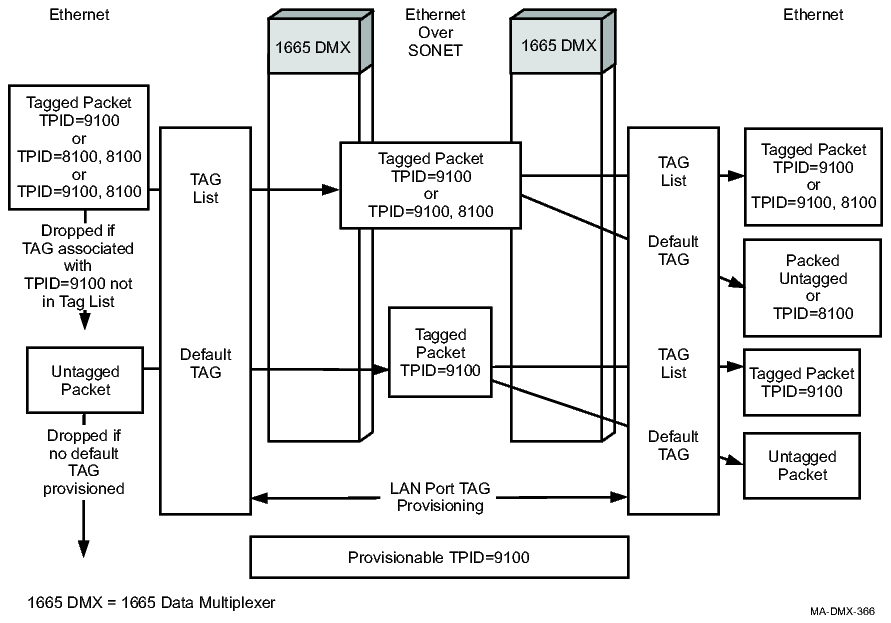Tagging Modes
Overview
Alcatel-Lucent 1665 DMX supports the following tagging modes.
The tagging mode is user provisionable on a circuit pack basis. Different circuit packs on a single Alcatel-Lucent 1665 DMX shelf can be provisioned for different modes but, all ports on a circuit pack must use the same mode.
Private line mode
The Private Line mode (also known as no tag or repeater mode) is used to establish simple point-to-point connections between two ports with no Ethernet switching functions applied. No additional Ethernet provisioning is required after the cross-connection is established. Private line mode can be used to provide either a full rate or sub-rate (fractional rate) dedicated Ethernet link across SONET networks. No preferential treatment for high priority packets is provided. In a sub-rate service, frames may be dropped due to congestion. Any correctly formatted Ethernet frame received at a source port is transmitted out of the destination port.
The Private Line mode supports the following features:
-
Protection is provided at the SONET network layer by either UPSR switching
-
No spanning tree protocol (supports transparency of customer spanning tree protocol)
-
No VLAN ingress filtering or classification (VLAN tags are not verified or added)
For packet size info, see Packet size in different tagging modes.
Switched mode
Switched mode allows 802.1Q or Transparent mode to be selected based on a virtual switch (grouping of ports) and Pack equippage. For more information, see Virtual switch, QoS services (LNW170).
802.1Q VLAN mode
In 802.1Q Mode, a circuit pack can be provisioned to use an incoming frame's VLAN tag, to add a VLAN tag associated with the port for untagged frames, or to drop an incoming frame if its VLAN tagging does not meet provisioned specifications. The priority bits in an incoming frame's VLAN tag can also be used to affect the handling of the frame.
The following table summarizes the 802.1Q Mode VLAN ID and Frame Priority Rules. For more information regarding frame priority rules on the LNW170, see QoS services (LNW170).
|
Frame Contains a VLAN Tag |
Ingress Port is Provisioned with a Default |
Results | |
|---|---|---|---|
|
VLAN ID |
Priority | ||
|
Yes |
Don't Care |
Yes |
The frame's VLAN ID is used. It must be on the Port's VLAN List, otherwise the frame is discarded. The port's user_priority field is used for queuing. |
|
No |
The frame's VLAN ID is used. It must be on the Port's VLAN List, otherwise the frame is discarded. The frame's priority is used for queuing. | ||
|
No |
Yes |
Yes |
A VLAN tag is added to the frame containing the port's default VLAN ID and priority. |
|
No |
A VLAN tag is added to the frame containing the port's default VLAN ID and the priority is set to low (VLAN Tag's User_priority field set to 0). | ||
|
No |
Don't Care |
Frame is dropped. | |
A VLAN ID can only be assigned to one virtual switch on a circuit pack.
On the LNW170/78, the same VLAN ID can be assigned to different virtual switches on the same pack.
When using the 802.1Q mode, a service provider must coordinate (specify) the use of VLAN IDs with customers. If a VLAN ID is assigned to more than one customer, the customers could receive each others traffic.
In Alcatel-Lucent 1665 DMX, the VLAN ID may be a numerical value in the range 1–4093.
If a port has been provisioned with a default VLAN ID for untagged frames, all incoming untagged frames (this includes frames containing a VLAN tag with a TPID value other than 8100hex) will have VLAN tag added with the default VLAN ID. Any frame exiting the Alcatel-Lucent 1665 DMX network tagged with the default VLAN ID will have its VLAN tag removed before the frame is sent out the LAN port. Thus, assuming symmetric provisioning at the network edges, frames that enter the Alcatel-Lucent 1665 DMX network untagged will leave untagged as well.
Frames that enter the network carrying a standard 802.1Q VLAN tag (identified with a TPID value of 8100hex) have their VLAN ID checked against a VLAN list for the entry port. If a match is found, the frame is admitted; otherwise, the frame is discarded. On exiting the network, customer-tagged frames are delivered with the customer-provided VLAN tag intact unless it matches the default VLAN ID for the exiting port. In such a case, the customer-provided VLAN tag is removed before the frame is delivered.
The following figure shows the end-to-end frame processing combinations considering the following:
Figure A-24: 802.1Q mode VLAN tag processing

If VLAN tags are used, the ports support a maximum packet size of 1536 bytes (10236 for LNW170). If VLAN tags are not used, the ports support a maximum packet size of 1532 bytes (10240 for LNW170).
The LNW170 circuit packs support the 802.1Q mode.
Important! After the VLAN ID is provisioned for untagged incoming Ethernet frames and service is established in the 802.1Q mode, changing the VLAN ID may affect service. When the VLAN ID for untagged incoming Ethernet frames is changed at one point in the network, the VLAN ID must be changed at all points. If the VLAN IDs are different, service is affected.
Transparent mode
In Transparent Mode, port tags (which are actually VLAN tags with a provisionable TPID value) are used to separate traffic for different customers. A port tag is added to each incoming frame at the ingress LAN port. The port tag contains a provisionable customer ID and priority level.
The port tag, along with the destination MAC address, is used in switching the Ethernet frame to its correct destination. Assuming the destination port is also provisioned for Transparent Mode, the port tag is removed as the frame is delivered out the destination port.
When using the Transparent Mode, service providers usually assign one customer ID to each customer LAN port. The service provider need not coordinate the selection of this customer ID with the customer since it is independent of any 802.1Q VLAN tags generated by the customer. Customers can use any VLAN ID they want without interfering with any other customer carried on the service provider's network.
In the transparent mode, the ports support a maximum packet size of 10240 bytes (LNW170).
The LNW170 and LNW910 circuit packs support the transparent mode. The LNW74 circuit packs do not support the transparent mode.
The following figure shows end-to-end frame processing combinations considering the following:
Figure A-25: Transparent mode tag processing

TPID provisioning and tag list provisioning
The value of the TPID (Ethertype) parameter used with generated VLAN Tags can be provisioned (in transparent mode only). Also, the user may provision a list of acceptable customer tags for a LAN port. This pair of features allows Alcatel-Lucent 1665 DMX to interoperate with other equipment that supports stacked VLANs.
The following figure shows the end-to-end frame processing combinations considering the following:
Figure A-26: Transparent mode tag processing with stacked VLANs

Packet size in different tagging modes
The following table shows a comparison of the Ethernet tagging modes.
|
Tagging Mode |
Max. Frame Size (Bytes) 1 |
Applicable Circuit Packs |
Max MTU size (Bytes) 2 |
|---|---|---|---|
|
Private Line |
9632 |
LNW74 |
9614 |
|
10240 |
LNW63, LNW64, LNW87, LNW170, LNW705, LNW910 |
10222 | |
|
802.1Q and Transparent |
1536 (Tagged) 1532 (Untagged 3) |
NA |
NA |
|
10240 |
LNW170 |
10222 |